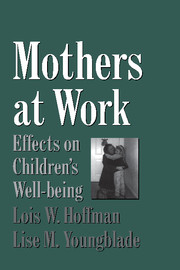Book contents
- Frontmatter
- Contents
- Preface
- 1 Introduction and Review of the Literature
- 2 Methodology
- 3 Children's Daily Family Lives: The After-School Day Interview
- 4 The Husband–Wife Relationship
- 5 The Mother's Well-being
- 6 Childrearing
- 7 Maternal Employment and Child Outcomes: The Direct Relationships
- 8 The Father's Role, Gender Attitudes, and Academic Outcomes
- 9 The Mother's Well-being and Child Outcomes
- 10 Childrearing Patterns and Child Outcomes
- 11 Nonmaternal Care and Supervision: Prevalence and Effects of Child-care Arrangements on Child Well-being
- 12 Summary and Overview
- Appendix: Measures Developed for This Study
- References
- Author Index
- Subject Index
10 - Childrearing Patterns and Child Outcomes
Published online by Cambridge University Press: 06 July 2010
- Frontmatter
- Contents
- Preface
- 1 Introduction and Review of the Literature
- 2 Methodology
- 3 Children's Daily Family Lives: The After-School Day Interview
- 4 The Husband–Wife Relationship
- 5 The Mother's Well-being
- 6 Childrearing
- 7 Maternal Employment and Child Outcomes: The Direct Relationships
- 8 The Father's Role, Gender Attitudes, and Academic Outcomes
- 9 The Mother's Well-being and Child Outcomes
- 10 Childrearing Patterns and Child Outcomes
- 11 Nonmaternal Care and Supervision: Prevalence and Effects of Child-care Arrangements on Child Well-being
- 12 Summary and Overview
- Appendix: Measures Developed for This Study
- References
- Author Index
- Subject Index
Summary
In this chapter, childrearing patterns are examined as links between maternal employment and child outcomes. In Chapter 6, differences in the childrearing styles of employed and nonemployed mothers were reported. This chapter extends these findings by examining the relationships between the parenting styles already tied to the mother's employment status and child outcomes.
Thus, we begin this chapter with a review of the results presented in Chapter 6. These findings showed that, across marital status, employed mothers were less likely to use an authoritarian style of control, and they showed less differentiation between sons and daughters in their discipline style and in their goals for children. In the one-parent sample, all of whom are working class, employed mothers also indicated more use of authoritative discipline, a style of control tempered by explanations and allowing input from the child. In the two-parent families, consistent with the general pattern, the full-time homemakers stressed obedience as their goal for children, but, particularly in the working class, they also indicated more permissiveness than the employed mothers. In addition, the homemakers held lower educational expectations for their children. With respect to child monitoring, there was only one significant difference: sons in dual-wage working-class families were more likely to be left unsupervised and unmonitored.
Mothers reported the frequency of their interactions with their child over the previous week. For middle-class, married mothers, the full-time homemakers indicated more frequent positive and educational interactions with their children; for working-class, married mothers, more frequent positive and educational activities with daughters were reported by the employed mothers and there was no difference for sons.
- Type
- Chapter
- Information
- Mothers at WorkEffects on Children's Well-Being, pp. 228 - 255Publisher: Cambridge University PressPrint publication year: 1999



